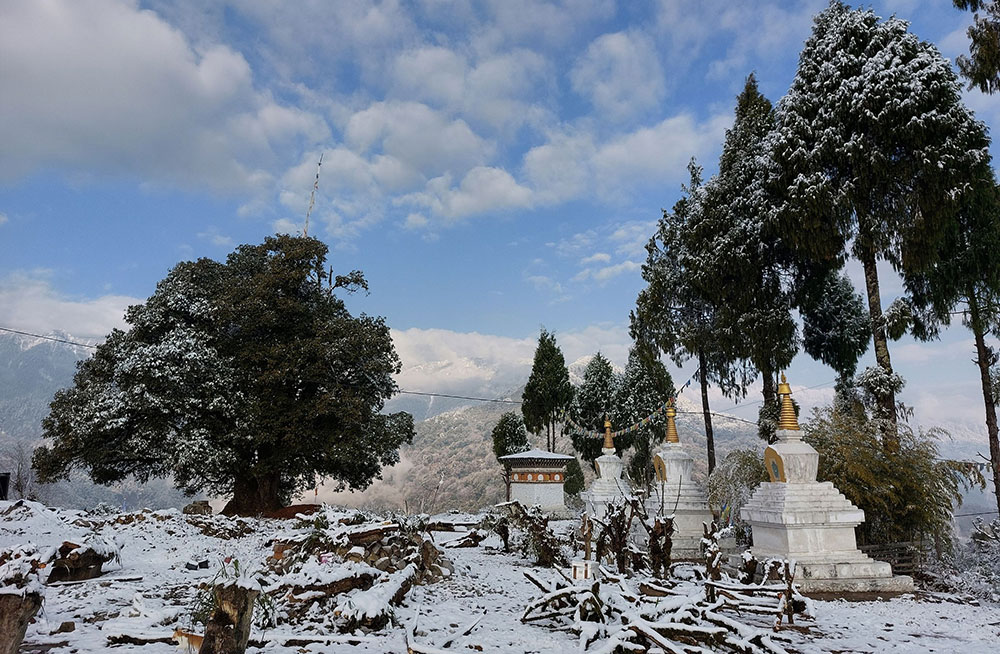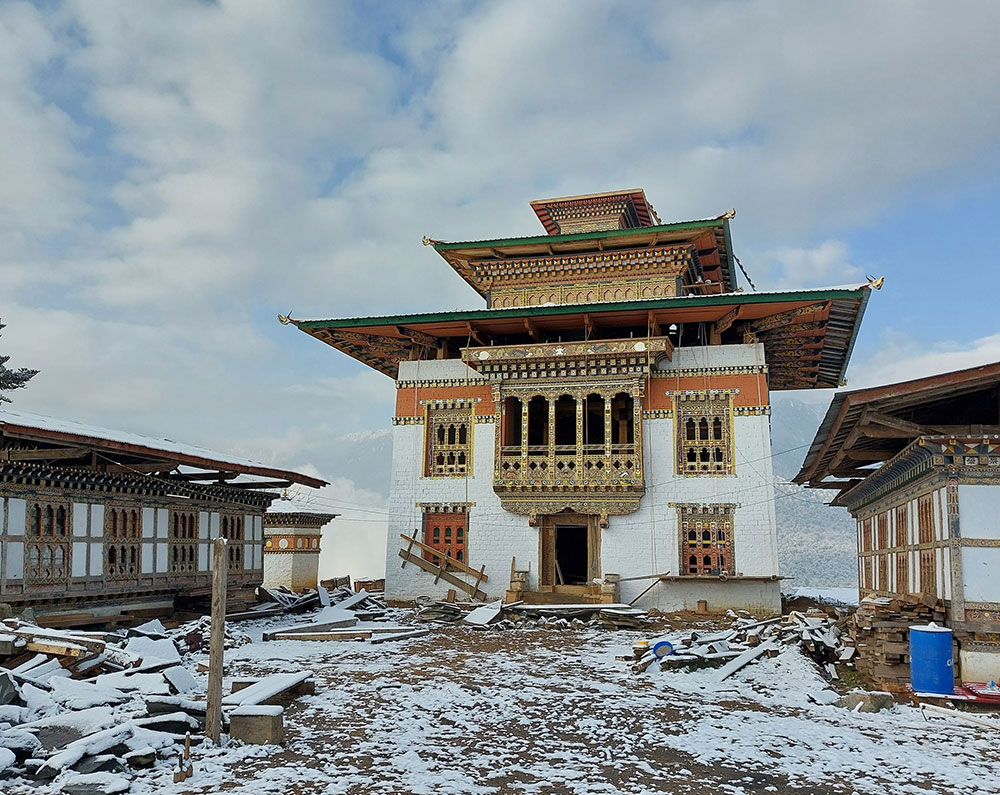Chencho Dema
PUNAKHA – Perched majestically at 2,350 meters, Nangsoel Goenpa crowns a mountain, offering a tranquil haven with a sweeping panorama of the upper Punakha valley.
This three-storey lhakhang not only captivates visitors with its breathtaking vistas but is also currently undergoing a meticulous restoration process.
Nestled in Sedchena village of Goenshari, Punakha, the monastery presents a visual feast with Dochula to the south, Namgyel Tse to the east, Thankargang mountain to the west, and the picturesque Gasa region to the north. To the southeast, charming hamlets and terraced fields complete this picturesque landscape.
Accessible by road, the journey to goenpa transcends a mere travel experience; it mirrors a pilgrimage, offering a serene escape approximately 34 kilometers away from the Punakha Dzong.
Lam Tandin Gyeltshen, the custodian of Nangsoel Goenpa, shared its rich history. Built in the 1350s by Drupthob Barawa Gyeltshen Pelzang, over 250 years before Zhabdrung Ngawang Namgyel’s arrival in Bhutan, it stands as one of the oldest monasteries in Punakha.

Ancient stupas at Nangsoel Goenpa
Drupthob Barawa (1310-1391), founder of the Barawa Kagyu sect of Vajrayana Buddhism, crafted and managed several monasteries in western Bhutan. The monastery has since witnessed the grace of esteemed spiritual leaders throughout the centuries.
In the 17th century, Nangsoel Goenpa served as the winter retreat for the revered Chari Drubchen Rigzin Dorji Chheowang. His disciple, Kunzang Dorji Rechen, not only renovated the monastery but also founded the esteemed meditation institute, Nangsey Jampaling Drubdhey. Lama Sangay Rinchen, the reincarnation of Kunzang Rechen, continued this legacy by dedicating himself to preserving the sacred heritage of the monastery.
During the 60th Je Khenpo Jamgon Ngawang Thinley’s visit, he described Nangsoel Goenpa as “Ganden,” a heavenly realm, underlining its spiritual significance and awe-inspiring natural beauty.
Local lore narrates that the 9th Je Khenpo Shakya Rinchen engaged in meditation at the monastery. During his stay, a severe smallpox epidemic gripped nearby villages. Motivated by profound empathy, Shakya Rinchen harnessed his meditative strength, absorbing the suffering onto himself. Astonishingly, the villagers recovered, and Shakya Rinchen bore visible smallpox scars—a lasting testament to his extraordinary sacrifice.
Nangsoel Goenpa is believed to be situated on a sacred mound inhabited by Tshering Chenga, the embodiment of the five longevity sisters in Buddhism. The Goenpa is renowned for its Boomi Chorten, believed to be blessed by Khandro Boom (Hundred thousand Dakinis). Surrounding the monastery are ancient stupas in four cardinal directions, one in the east constructed using Lama Sangay Rinchen’s ashes.
Just below the monastery lies a historic rock, believed to be where Drubthob Barawa triumphed over a demoness. The rock bears imprints of the demoness’s flayed skin, the Lama’s footprint, and the whip (Techha) used to subdue her. On a neighbouring mountain are imprints resembling the demoness’s five fingers—a lasting memorial of Lama Barawa’s pivotal moment.
Nangsoel Goenpa safeguards revered relics, including conch shells once owned by Shakya Rinchen, traditionally sounded to ward off natural calamities. The lhakhang houses the hallowed robes of Kunzang Rechen and Sangay Rinchen, accompanied by their effigies, as well as a statue commemorating Barawa Gyeltshen Pelzang and Shakya Rinchen. Ancient statues of Buddha Shakyamuni, Tshepame (Amitayus), Mithrukpa (Akshobhya), and Tshering Chenga grace the sacred space.
Despite resource constraints, ongoing restoration work led by Lama Tandin Gyeltshen seeks to preserve the monastery’s history and cultural heritage. Facing financial challenges, the restoration project strives to safeguard the sanctity of this ancient monastery, a beacon in the region’s history.


